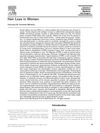TLDR Early diagnosis and treatment are crucial for managing female hair loss effectively.
Aurora Guerra-Tapia, a dermatologist, explores female alopecia, focusing on its emotional and psychological effects. She discusses types like androgenic, frontal fibrosing, and areata alopecia, and stresses early diagnosis and treatment, which may include hormonal therapies, antiandrogens, and minoxidil. She highlights the importance of recognizing related health issues, such as polycystic ovary syndrome and metabolic syndrome, and advocates for a comprehensive treatment approach, urging women to seek specialized dermatological care early.
 February 2024 in “ACS Omega”
February 2024 in “ACS Omega” The Shen Bai Hair Growing Decoction may help treat hair loss by promoting hair growth and reducing inflammation.
 81 citations
,
March 2009 in “Seminars in Cutaneous Medicine and Surgery”
81 citations
,
March 2009 in “Seminars in Cutaneous Medicine and Surgery” Effective hair loss treatment in women requires correct diagnosis and can include medications like minoxidil, antiandrogens, and treatments for underlying conditions like PCOS.

Advancements in diagnostics, treatments, and technology have improved hair loss detection and restoration, with some types being reversible.
 1 citations
,
May 2025 in “Maturitas”
1 citations
,
May 2025 in “Maturitas” Menopause can cause hair loss in women due to hormonal changes, affecting their well-being and quality of life.
 1 citations
,
July 2017 in “Clinical research in dermatology”
1 citations
,
July 2017 in “Clinical research in dermatology” Hair loss, known as Androgenetic Alopecia, is often caused by hormones and can be diagnosed using noninvasive techniques. Treatments include topical minoxidil and oral finasteride, with new treatments being explored. There may also be a link between this type of hair loss and heart disease risk.






